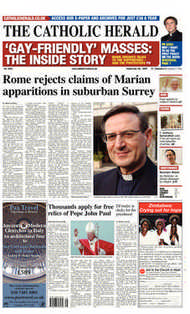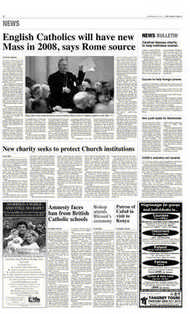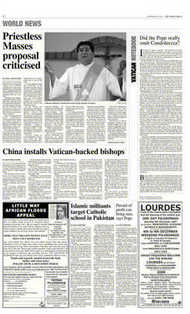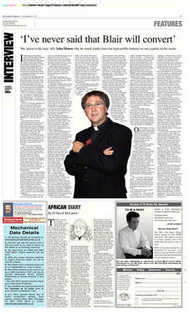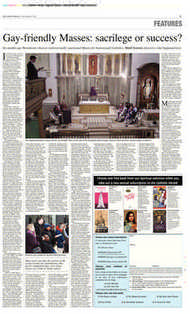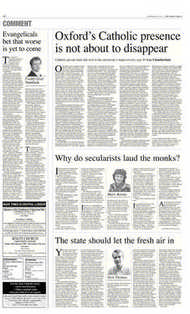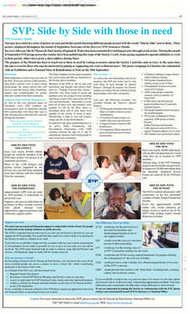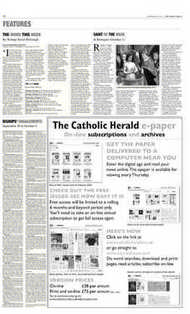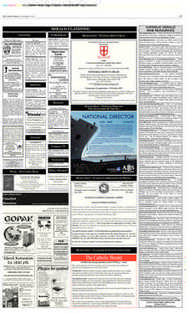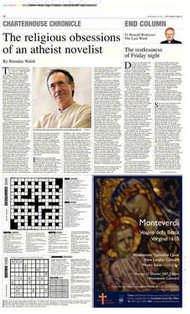Page 9, 28th September 2007
Page 9

Report an error
Noticed an error on this page?If you've noticed an error in this article please click here to report it.
Tags
Share
Related articles
Gay-friendly Masses Transferred To Catholic Church
Bishop Warned Of Vigilante Threat Over Soho Masses
Vatican Doctrinal Chief Gave Blessing To 'gay-friendly'...
Westminster Launches Virtual Diocese
Cardinal Refuses To Stop 'gay' Masses As They Double To...
Youtube Clip Sparks Outcry Over ‘dissent’ At Soho Mass
Gay-friendly Masses: sacrilege or success?
Six months ago Westminster diocese controversially sanctioned Masses for homosexual Catholics. Mark Greaves discovers what happened next In February this year the Diocese of Westminster established regular “gay-friendly” Masses at a church in central London. It was a groundbreaking development: no such Mass has ever been sanctioned by the Church.
It was approved by Cardinal Cormac MurphyO’Connor, the spiritual leader of Catholics in England and Wales, and – according to most of the people involved – had the blessing of several key Vatican figures, including Cardinal William Levada, the prefect of the Congregation for the Doctrine of the Faith (CDF).
Now, twice a month at the Warwick Street church in Soho, about 100 Catholics gather for a Mass that is “particularly welcoming to lesbian, gay, bisexual and transgendered Catholics, their parents, friends and families”.
Each time, a group of Catholics also assembles outside the church, on the pavement opposite the front entrance. They start praying 10 minutes before the Mass begins; they recite the rosary, sing hymns, say the Litany of Our Lady, the Divine Praises, and the Chaplet of Divine Mercy. The group – normally consisting of about a dozen people, but sometimes up to 35 – stand or kneel on the pavement for about an hour and a half. Just around the corner from the neon-lit bustle of Soho, the scene would surprise a passerby.
The protesters pray in reparation for what they see as a scandal happening inside the church. They say that the gay-friendly Mass does not just give extra pastoral support to a harassed minority, but that it actually encourages “active” homosexuals, who do not live according to the teaching of the Church, to receive Holy Communion.
The diocese in its statement in February insisted that it was following traditional Church principles. It quoted from the Catechism of the Catholic Church and from a document issued by the Congregation for the Doctrine of the Faith in 1986, On the Pastoral Care of Homosexual Persons, saying that while gay sexual activity was “objectively disordered”, a homosexual inclination should never be considered sinful in itself. Gay Catholics should “continue to look to the Church for a place where they might live in authentic human integrity and holiness of life”. The Masses, therefore, were merely an effort to meet the pastoral needs of a particular part of London’s population.
But protesters point to the civil partnerships registered by some of the people who organise the Mass (known as the Soho Masses Pastoral Council, or SMPC). They argue that these people are objectively in a state of sin and should not receive Communion at a Mass endorsed by the Church.
Mass-goers, meanwhile, claim that the actions of the group outside are intimidating and unChristian. One priest complained that they were using prayer as a kind of “battle attack”. Their hymns can be heard clearly inside the church during the sermon and the readings, and the Mass itself has been disrupted several times. One woman was even confronted at the door by a man who said she had no right to go inside.
Martin Pendergast, secretary of the SMPC, has helped to arrange unapproved Masses for gay and lesbian Catholics for several years. He thinks they fill an important gap in the Church’s pastoral care and help to bring Catholics who have lapsed for up to 20 years back to their faith.
“There’s a deep silence when it comes to lesbian and gay people,” he said. “How often would you hear a sermon that speaks even halfpositively about the rights of lesbian and gay people to even be in the church?”
The gay-friendly Masses are important for the parents and families of gay people, too. “This is often not written about,” says Mr Pendergast. “Parents actually feel the pain more crucially than lesbian and gay people themselves because the language of official teaching suggests to parents the child they’ve produced is a freak, is disor
dered. Here they have a son or a daughter who they’ve brought up just like any other child of their family, who they love, and they know the truth about that child. But the message they hear from Church teaching – I’m not saying this is the message the Church wants give – is that this thing you’ve produced is not like your other children. It is objectively disordered. Parents feel guilt, anger, frustration, because this does not accord with the child that they know.” Mr Pendergast points out that one mother travels from Somerset so that she can attend Mass with her gay son.
Masses for gay and lesbian Catholics have been held in London without the approval of the diocese since 1999. For most of that time they have been celebrated at St Anne’s Anglican church in Soho with priests brought in from other parts of the country and from religious orders.
Last year the diocese asked the organisers to transfer the Masses to a Catholic church and make them an official part of the Church’s pastoral outreach.
The move was instigated by Cardinal Murphy O’Connor himself, according to Fr Shaun Middleton, parish priest of St Francis of Assisi in Notting Hill, who said the Cardinal wanted to provide more care for homosexual Catholics in the diocese. Intensive discussions were held between the SMPC and the diocese – Bishop Bernard Longley in particular – for about four months. The talks involved people “at the highest levels” in the Vatican, particularly in the CDF. The Vatican spokesman, Fr Federico Lombardi, has repeatedly denied that the Masses were “authorised” by Rome. But, according to Mr Pendergast, a draft of the diocesan statement was amended several times by senior Vatican officials.
Mr Pendergast explained: “It was felt that if we could get this right here in London then it could provide a model for other places where there has been a much more antagonistic stand-off between the gay community and the Church – in the United States, for instance.” The diocesan statement that was eventually released in February said that the Masses were “not to be used for campaigning for any change to, or ambiguity about, Church teaching”. This is a key idea: both the SMPC and the diocese have tried to keep the Masses free of political undertones. There will be no dissenting homilies, and the liturgy will conform to standard practice. The SMPC itself, unlike the Roman Catholic Caucus of the Lesbian and Gay Christian Movement, is not officially critical of Church teaching, even though some of its members may be.
The first Mass, celebrated on Sunday, March 4, drew almost 200 people, including 21 protesters. Relations between the two groups were remarkably amicable: Massgoers even invited the protesters inside for tea and cake.
The Mass was punctuated by one silent piece of theatre. A man who had sat among the congregation walked to the front of the nave just as the priest was beginning the liturgy of the Eucharist. He held up a picture of the Sacred Heart for about 10 seconds, first to the congregation and then to the altar. He then genuflected and abruptly left the church. Since that first mysterious visitor the Mass has been disrupted several times, according to the SMPC. In April the slot within the liturgy for spontaneous prayer was suspended after “offensive interventions” from protesters. Mr Pendergast said one prayer had called for everybody in the church to “desist” from taking the Eucharist and “reorder themselves to their proper sexuality”. Someone else, meanwhile, expressed the hope that there would be no “sacrilegious” Communions.
“A group of women were very distressed by this,” said Mr Pendergast. “They felt it was a kind of spiritual violence and said that if it was going to continue they didn’t feel they could continue to come to the Mass.” After these events the SMPC asked the congregation to e-mail prayers beforehand: the spontaneous bidding prayer was no more.
There was further trouble, however. On one occasion a man stood by the entrance of the church, stopping people who were heading inside. He asked them if they were a practising homosexual and said that if they were they had no right to go into a church. After another Mass a woman was reportedly seen sprinkling holy water on the altar.
Mr Pendergast also complains of “vitriolic, highly personalised” attacks on members of the SMPC by groups such as Christian Order, Catholic Action and Pro Ecclesia et Pontifice.
He says he finds it “deeply offensive” that the protesters believe they can make judgments about other people’s internal state. According to Canon Law, he argues, the priest must always assume that the person approaching the Eucharist is doing so in good conscience, unless that person is in a public state of sin. As Bishop Longley said on Radio 4’s Sunday programme, the Church doesn’t do “means-testing” when it comes to the Eucharist.
Daphne McLeod and Michael Akerman, of Pro Ecclesia et Pontifice, organise the prayer vigil on Warwick Street. But they explain that they are not involved in any of the more militant forms of protest. In fact, when one man started intimidating people in the doorway they were able to persuade him to stop and pray with them instead.
They have also assured the police that there will be no placard waving and no chanting of slogans. “We pray in a normal voice and sing in a normal voice – we don’t raise our voices deliberately,” said Mr Akerman. “There may well be a number of local parishioners or tourists, and we would not be very charitable if we were disturb ing their genuine worship.” Mrs McLeod said the idea that they were an intimidating presence was silly. “We’re on the other side of the street. The only thing I can think of is one of our members turns up with rather loud ties – perhaps that upsets them.” Members of the group travel from places as various as Nottingham, Reading, Basingstoke and Stroud; one 18-year-old even gets the train from Exeter. They come to Soho not to chain them selves to railings but to witness to what they see as sinful Communions.
Mrs McLeod admits that a person could receive Holy Communion while in a state of sin anywhere, in any parish, and no one would know. But in this case, she says, we do know: it is a matter of public record that members of the SMPC are in civil partnerships. She compares the situation to that of priests denying politicians who support abortion, or Cardinal George Pell’s refusal in 2002 to give Communion to members of the gay rights Rainbow Sash movement (they were identifiable because they wore rainbow-coloured sashes).
Pro Ecclesia regards the Masses as anything but apolitical. Mr Akerman points to bidding prayers at the Mass that celebrate civil partnerships, and to the SMPC’s participation in the Gay Pride march. He says that Catholics involved in the organisation Courage, which tries to support homosexuals in living a chaste life, do not see the need for a “special” gayfriendly Mass, and regard it as an intrusion of gay rights politics into the life of the Church.
Mark Dowd, chairman of Quest, a group of lesbian and gay Catholics, says that the Masses do not in any way encourage active homosexuality. “Rome would never countenance different moral teaching in London or anywhere else,” he says.
He also argues it is impossible to conclude that a person is sexually active simply because he or she has entered a civil partnership. “We can’t assume anything about their lives from that. What are people proposing – putting cameras in everyone’s bedroom?”
Mr Akerman and Mrs McLeod have sent letters to key figures in Rome, as well as Westminster, to try to get the Masses stopped. They have even met the papal nuncio, Archbishop Faustino Sainz Munoz. They suggest that the CDF has issued letters of concern about the Mass which Westminster has so far managed to ignore.
The diocese is planning to review the Mass next month as it promised to do in February. A diocesan statement issued on Monday did not rule out withdrawing the provision. It said that the review will cover “all aspects” of the Mass and that the Archbishop’s Council will consider its findings and “make a decision about the future direction of this pastoral outreach”.
Meanwhile, both Massgoers and protesters are determined to keep up their attendance. The fate of the Mass hangs in the balance: if the protesters succeed in their aims the Vatican will step in; but if the Mass is left to continue it could become a model for city dioceses throughout the global Church.
blog comments powered by Disqus


